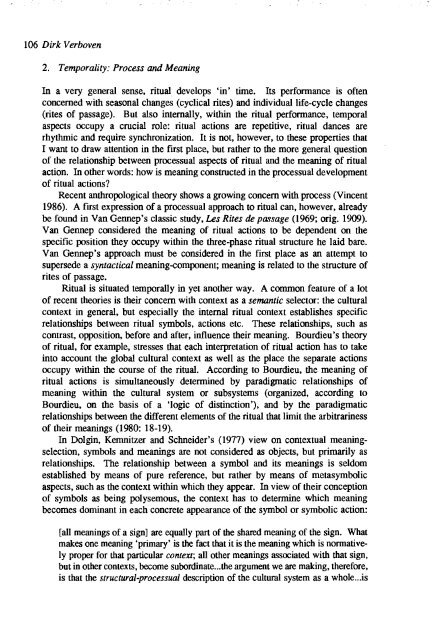1991 No. 1 CONTENTS - Institute of Social and Cultural ...
1991 No. 1 CONTENTS - Institute of Social and Cultural ...
1991 No. 1 CONTENTS - Institute of Social and Cultural ...
You also want an ePaper? Increase the reach of your titles
YUMPU automatically turns print PDFs into web optimized ePapers that Google loves.
106 Dirk Verboven<br />
2. Temporality: Process <strong>and</strong> Meaning<br />
In a very general sense, ritual develops 'in' time. Its performance is <strong>of</strong>ten<br />
concerned with seasonal changes (cyclical rites) <strong>and</strong> individual life-cycle changes<br />
(rites <strong>of</strong> passage). But· also internally, within the ritual performance, temporal<br />
aspects occupy a crucial role: ritual actions are repetitive, ritual dances are<br />
rhythmic <strong>and</strong> require synchronization. It is not, however, to. these properties that<br />
I want to draw attention in the first place, but rather to the more general question<br />
<strong>of</strong> the relationship between processual aspects <strong>of</strong> ritual <strong>and</strong> the meaning <strong>of</strong> ritual<br />
action. In other words: how is meaning constructed in the processual development<br />
<strong>of</strong> ritual actions?<br />
Recent anthropological theory shows a growing concern with process (Vincent<br />
1986). A first expression <strong>of</strong> a processual approach to ritual can, however, already<br />
be found in Van Gennep's classic study, us Rites de passage (1969; orig. 1909).<br />
Van Gennep considered the meaning <strong>of</strong> ritual actions to be dependent on the<br />
specific position they occupy within the three-phase ritual structure he laid bare.<br />
Van Gennep' s approach must be considered in the first place as an attempt to<br />
supersede a syntactical meaning-component; meaning is related to the structure <strong>of</strong><br />
rites <strong>of</strong> passage.<br />
Ritual is situated temporally in yet another way. A common feature <strong>of</strong> a lot<br />
<strong>of</strong> recent theories is their concern with context as a semantic selector: the cultural<br />
context in general, but especially the internal ritual context establishes specific<br />
relationships between ritual symbols, actions etc. These relationships, such as<br />
contrast, opposition, before <strong>and</strong> after, influence their meaning. Bourdieu's theory<br />
<strong>of</strong> ritual, for example, stresses that each interpretation <strong>of</strong> ritual action has to take<br />
into account the global cultural context as well as the place the separate actions<br />
occupy within the course <strong>of</strong> the ritual. According to Bourdieu, the meaning <strong>of</strong><br />
ritual actions is simultaneously determined by paradigmatic relationships <strong>of</strong><br />
meaning within the cultural system or subsystems (organized, according to<br />
Bourdieu, on the basis <strong>of</strong> a 'logic <strong>of</strong> distinction'), <strong>and</strong> by the paradigmatic<br />
relationships between the different elements <strong>of</strong> the ritual that limit the arbitrariness<br />
<strong>of</strong> their meanings (1980: 18-19).<br />
In Dolgin, Kemnitzer <strong>and</strong> Schneider's (1977) view on contextual meaningselection,<br />
symbols <strong>and</strong> meanings are not considered as objects, but primarily as<br />
relationships. The relationship between a symbol <strong>and</strong> its meanings is seldom<br />
established by means <strong>of</strong> pure reference, but rather by means <strong>of</strong> metasymbolic<br />
aspects, such as the context within which they appear. In view <strong>of</strong> their conception<br />
<strong>of</strong> symbols as being polysemous, the context has to determine which meaning<br />
becomes dominant in each concrete appearance <strong>of</strong> the symbol or symbolic action:<br />
[all meanings <strong>of</strong> a sign] are equally part <strong>of</strong> the shared meaning <strong>of</strong> the sign. What<br />
makes one meaning 'primary' is the fact that it is the meaning which is normatively<br />
proper for that particular context; all other meanings associated with that sign,<br />
but in other contexts, become subordinate ... the argument we are making, therefore,<br />
is that the structural-processual description <strong>of</strong> the cultural system as a whole .. .is
















